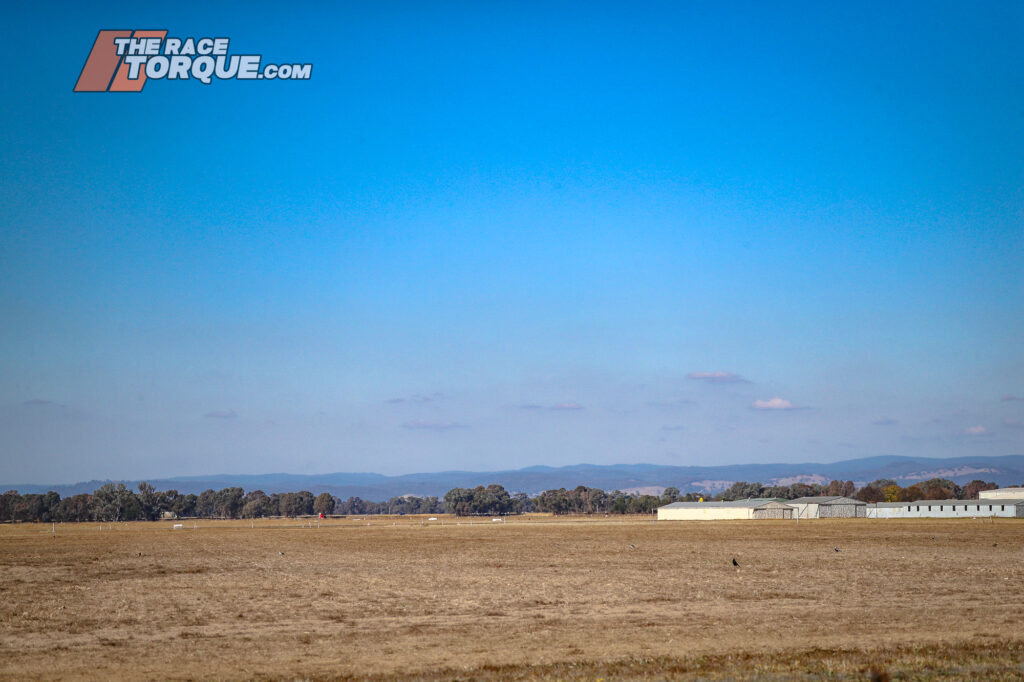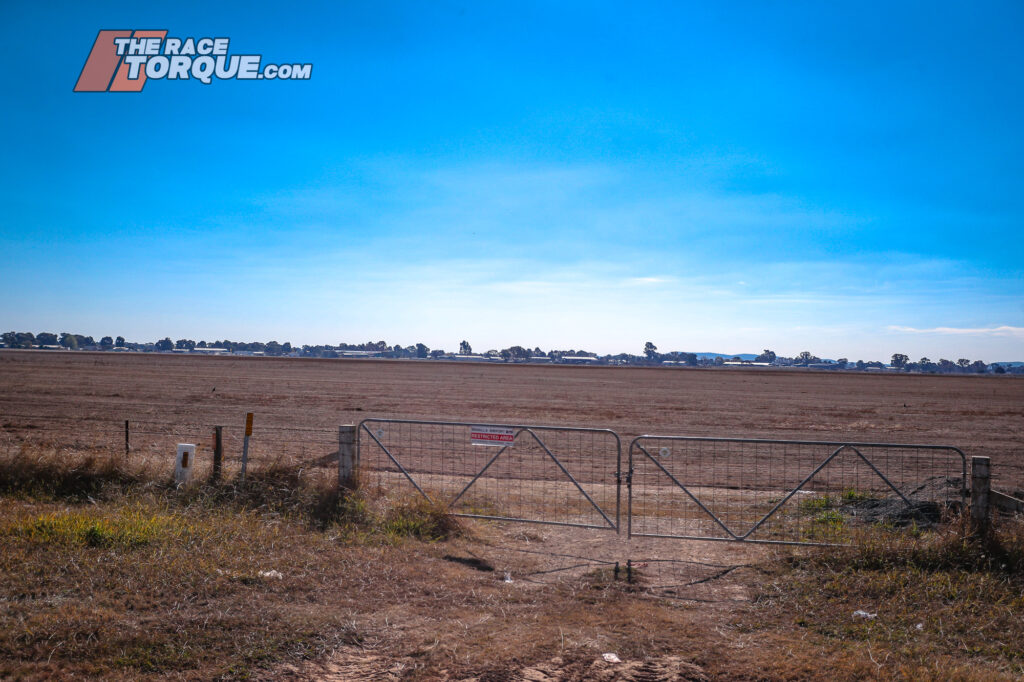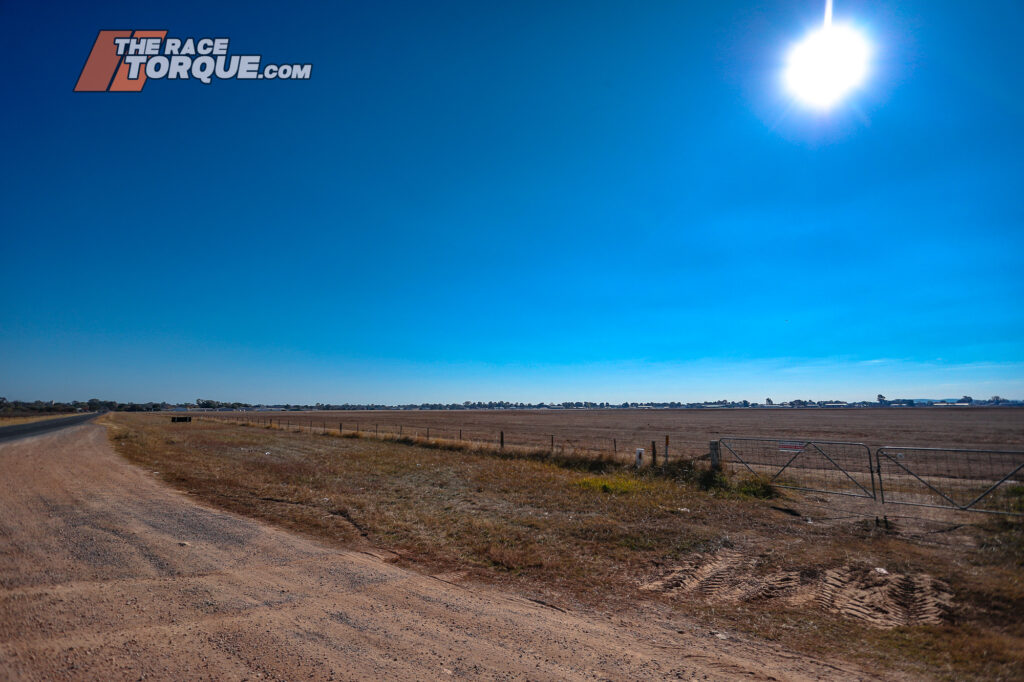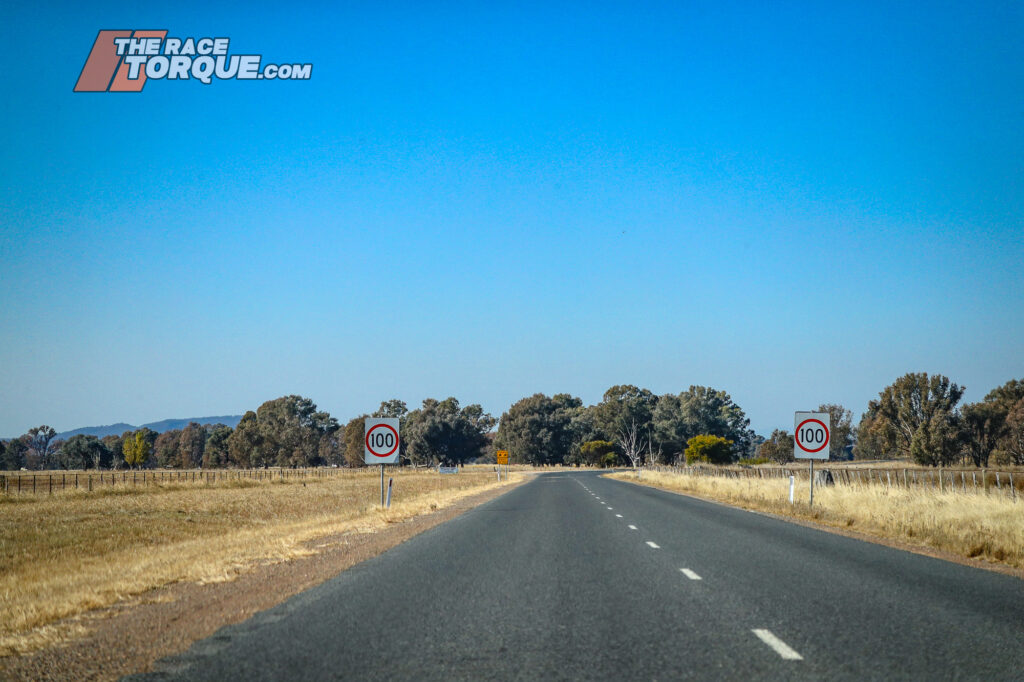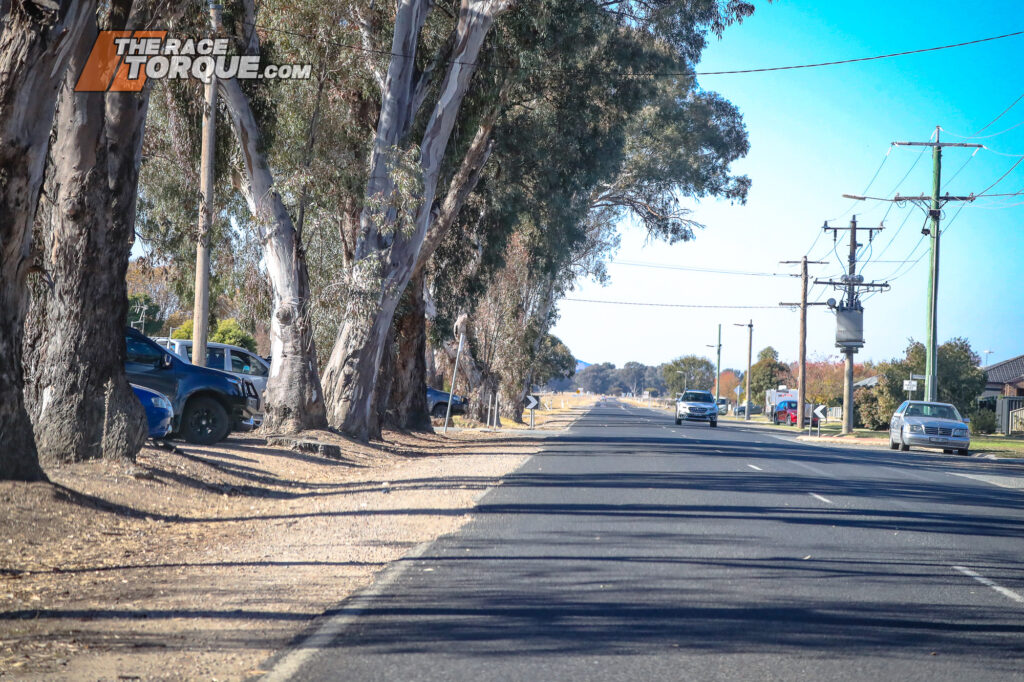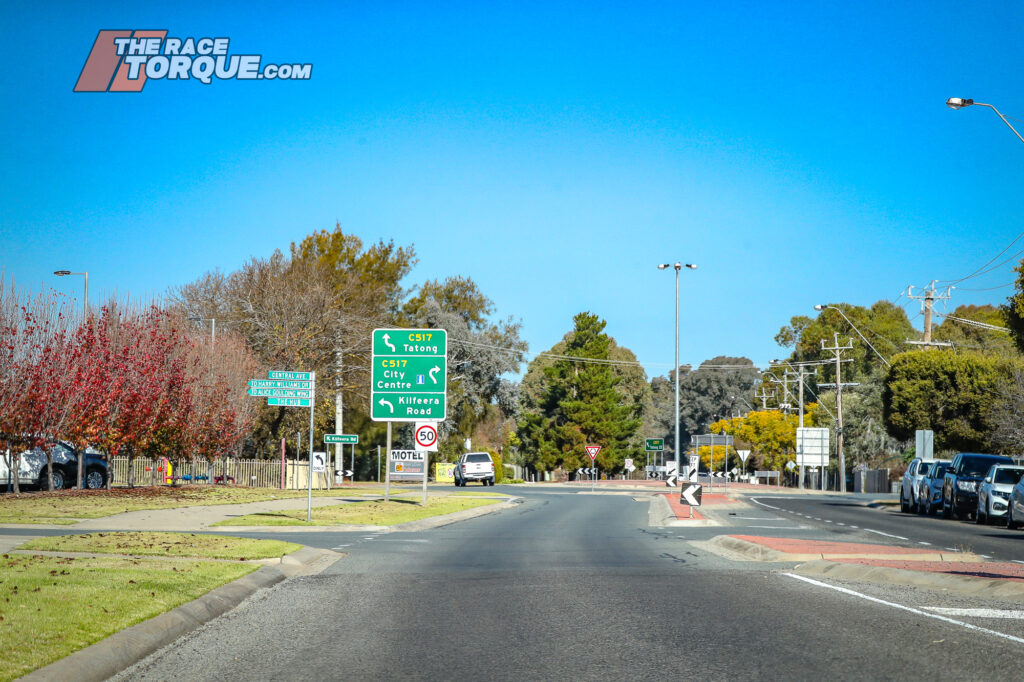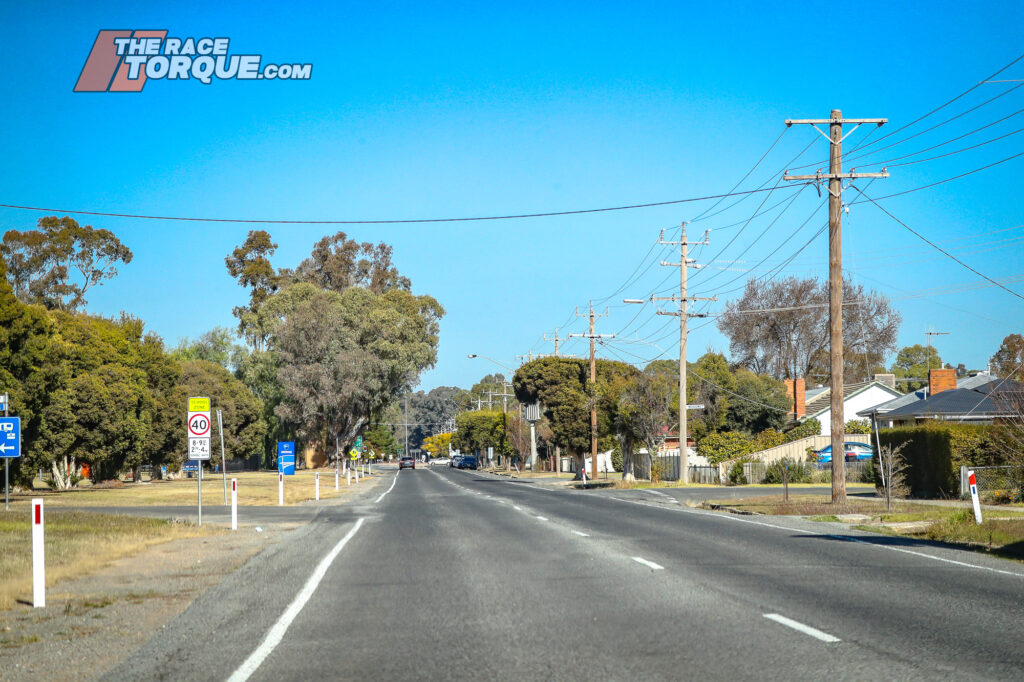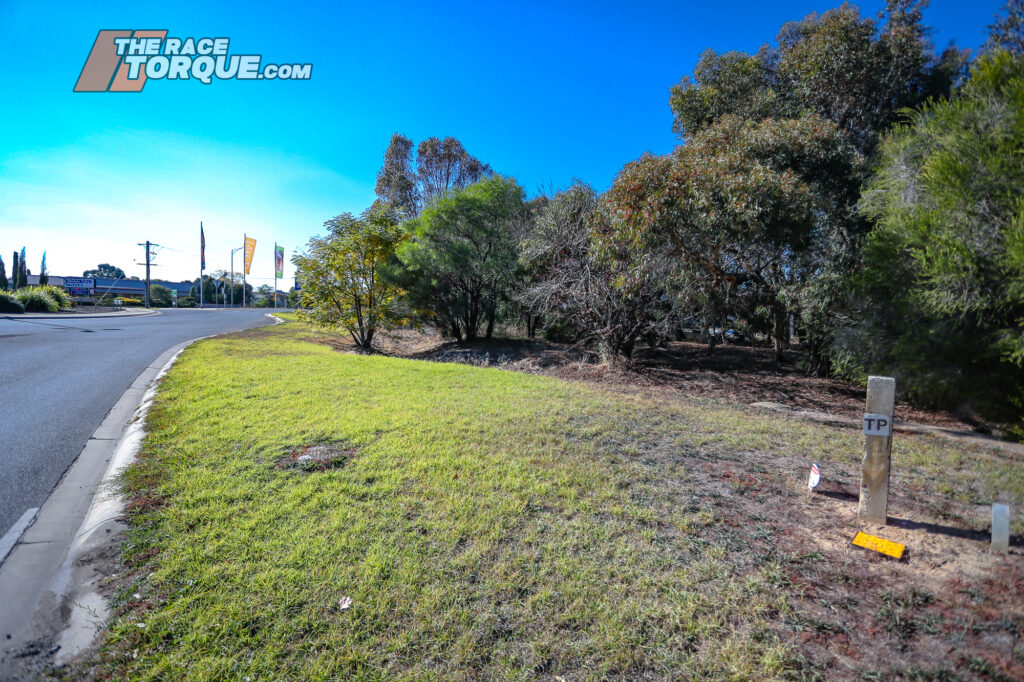A Time Before Winton: The Benalla Street Race
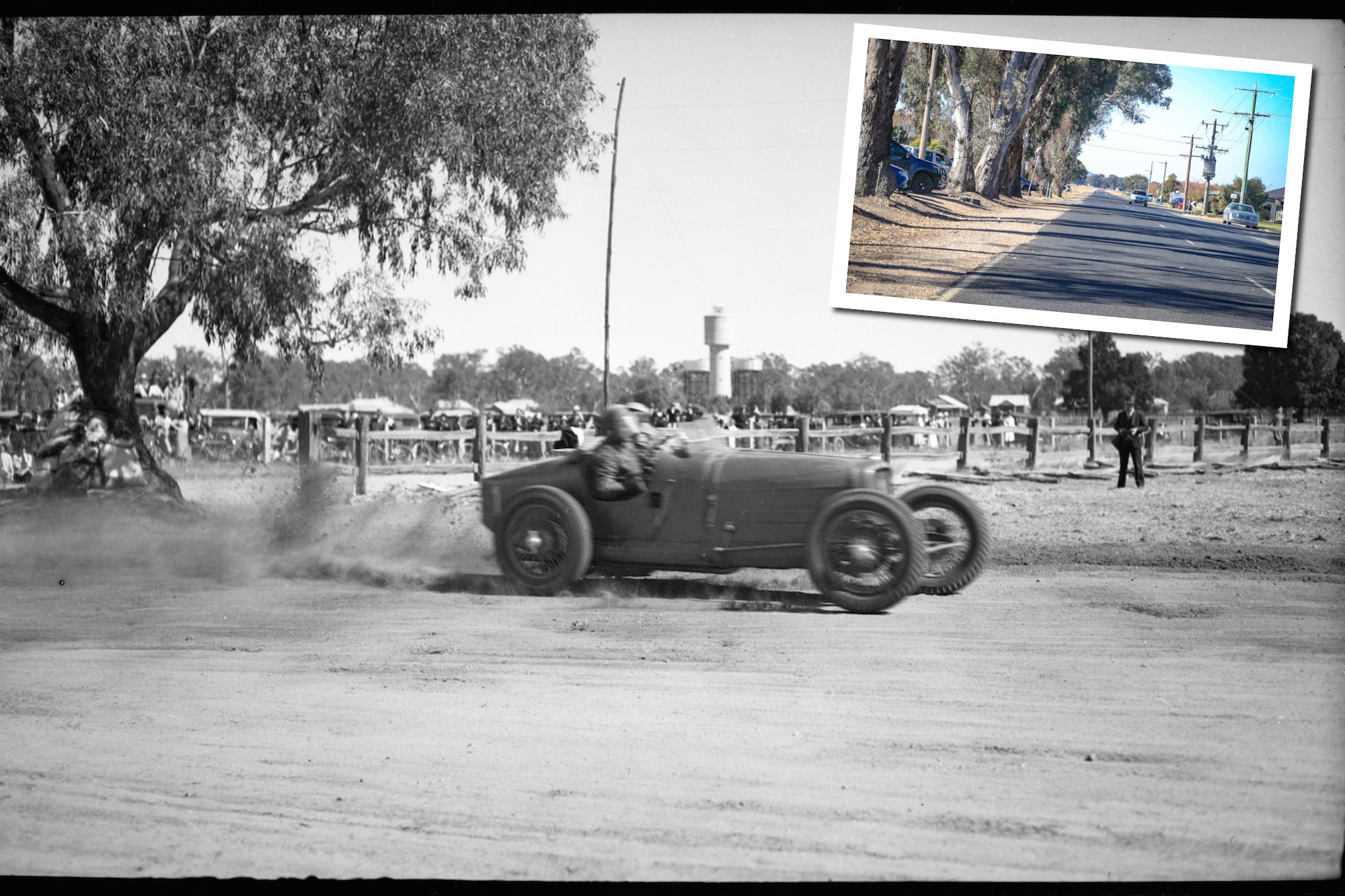
While Winton Motor Raceway continues to be one of the longest-serving permanent circuits in the nation, the area’s first car race was a true pioneer. In 1936, a triangular street course on the outskirts of Benalla hosted the first official car race ever contested on the public roads of mainland Victoria.
Organised by the Benalla Centenary Celebrations Committee and the Victorian Sporting Car Club (VSCC), the event was very much run against the odds, with the government of the time dead against motorsport on public roads.
Timeline of a Pioneering Event
28th February 1936
The concept of motorsport as a part of the Benalla centenary celebrations was first floated in the Benalla Standard newspaper as a possible part of the sports program at the “Back to Benalla Festival”. The wheels were quickly put in motion.
3rd March 1936
Following a visit by the President of the VSCC, the concept of a car race was firmed, with the possibility that Benalla could become a permanent fixture. Benalla was also floated as a replacement for Phillip Island, with the rural town far more accessible than the spiritual home of the Australian Grand Prix. Motorsport representatives and the council had examined some possible layouts for the track.
Norman Hamilton, Alan Hamilton’s father, was ultimately the driving force behind promoting the motorsport facets of the event.
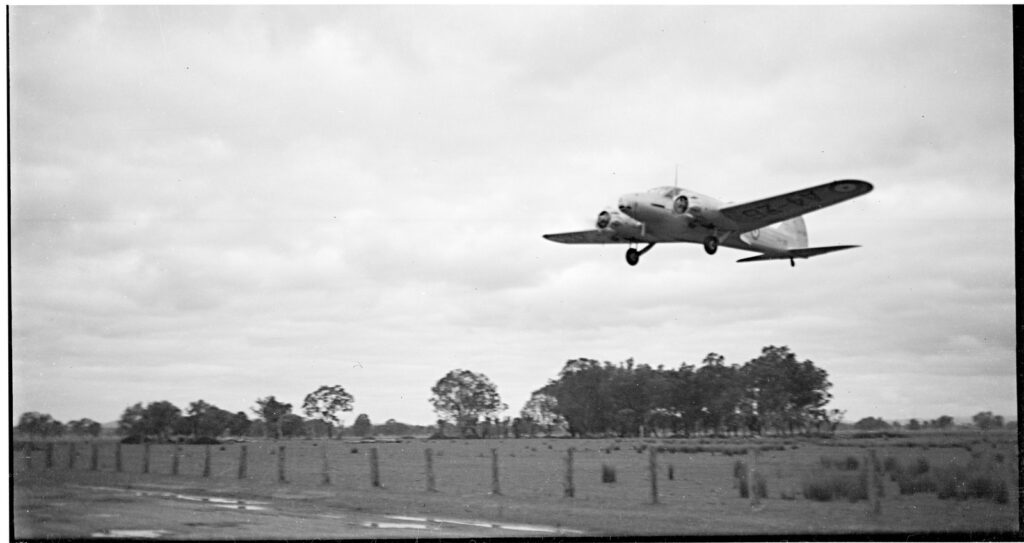
Benalla Airfield at the time – image State Library of Victoria
10th March 1936
A course encircling the town’s airfield was selected. The VSCC intimated that two sides of the triangular circuit were a little rough and it was suggested that if certain small repairs were done to these sections, it would be quite good for racing. The Club stressed that they weren’t requiring Hume Highway-spec roads, but they merely needed to be free from cracks. An article in the Benalla Standard noted:
“The Club pointed out that until the commencement of motor racing at Phillip Island, the Island was practically unknown, and now on motor race day, the crowd was always 12,000 at least. The Club had always run its races at Phillip Island, but owing to the inconvenience to the public with the dual road and boat travel, it had been seeking a circuit on the mainland.”
The same article reported on the council meeting discussing the prospective race.
Councillor T.F. Harrison said that he was opposed to closing the roads, noting that ratepayers could not come to town during the races. He suggested using a racecourse or some other private property would be more suitable.
Councillor Hanlon responded that there are shortcuts and backroads available, while a couple of panels of removed fence on a private property would ensure access in the local area. Cr. Hanlon also noted the value of attracting thousands of spectators to the town.
Councillor Tinkler noted that the races at Cowes were the “Lifeblood of the Island, and its progress has been mainly due to the car races held there.”
Ultimately, the council approved the running of the race.
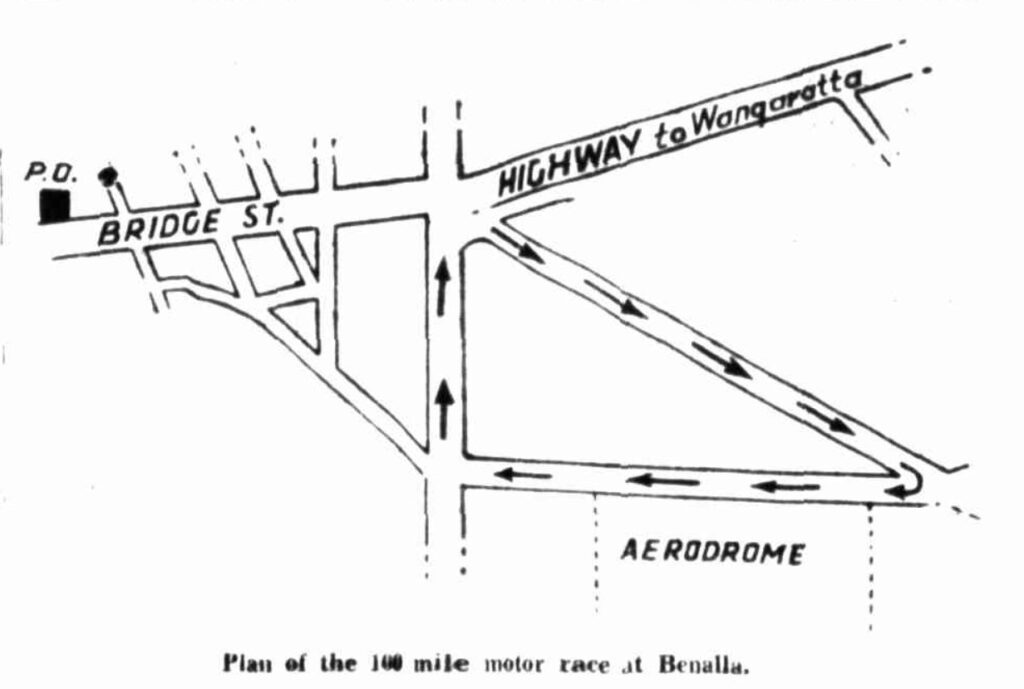
17th March 1936
This is the nearest approach in Australia to a “Round the Houses Race”, one of the most popular forms of motor racing in Europe. The first “Round the Houses Race” was held in Monte Carlo, but now spread to all the principal motor racing countries, including Ireland and the Isle of Man. The race at Benalla will do much to popularise motor racing in Victoria. The track is situated so close to the town that spectators will have little distance to travel to the vantage points.
Benalla Standard
20th March 1936
The front page of the Benalla Standard led with confirmation of the 100-mile road race, which would headline celebrations. A specially prepared course close to town would host some of Australia’s best race cars, and at least £100 would be raised for use as prize money. Money would be raised through the sale of grandstand seats, which would be constructed with donated timber at a cost of £2 for the labour. The city engineer noted that considerable work would have to be carried out on the course to prepare it for competition. The cooperation of surrounding properties was achieved, ensuring the passage of traffic to the town, while care would have to be taken with regard to the nearby Bush Nursing Hospital.
22nd March 1936
A delegation from the motorsport fraternity was met by around 30 members of the event’s organising committee, with everything noted as being in hand. Efforts were being made to ensure that the event received a radio broadcast and would also be filmed. The visitors were impressed by the layout, which was noted as being much wider than the backroads of Phillip Island.
27th March 1936
Special trains from Melbourne would be arranged to transport spectators to the Easter Monday race. Also, the North Eastern Ensign reported:
The winner of the race will receive in addition to prize money a beautiful gold cup which has been donated by Sydford Motors of Bridge Street, Benalla. The cup will be known as the Golden Fleece Cup.
3rd April 1936
The racetrack was noted as being rolled, watered, and ready for action. By this stage, the event was getting major attention in the press from around the nation.
9th April 1936
The program for the Easter gala week featured:
Thursday night – Visitors start arriving
Good Friday – Church services, band recital in the Botanical Gardens, Sacred Concert at night in the Shire Hall, Benalla Cricket Association Final – first day.
Easter Saturday – Visitors reception in the Shire Hall, Benalla Racing Club Meeting, Clay Bird Shooting, Cricket continued, Boxing Club Rink Tour, Monster Old-Time Dance, Benalla High School’s 21st Birthday, Benalla Fire Brigade Reunion.
Easter Sunday – Special services in Churches, Pleasant Sunday Afternoon in the Gardens, Sacred Concert.
Easter Monday – The Monster Carnival Day, £100 Motor Race, Grand Procession, Sports Carnival in Showgrounds, Boy Scouts’ Demonstration, Torchlight Procession, Grand Modern Ball in Drill Hall, Pictures in the Shire Hall, I.O.R. Reunion.
Easter Tuesday – Back to Schools, Back to Benalla Reunion Picnic in the Gardens, Cricket match in the Gardens, Monster Card Evening, Masonic Reunion.
Wednesday – Motor trips to beauty spots, Grand Final Concert Musical Competitions, M.U.I.O.O.F. Reunion.
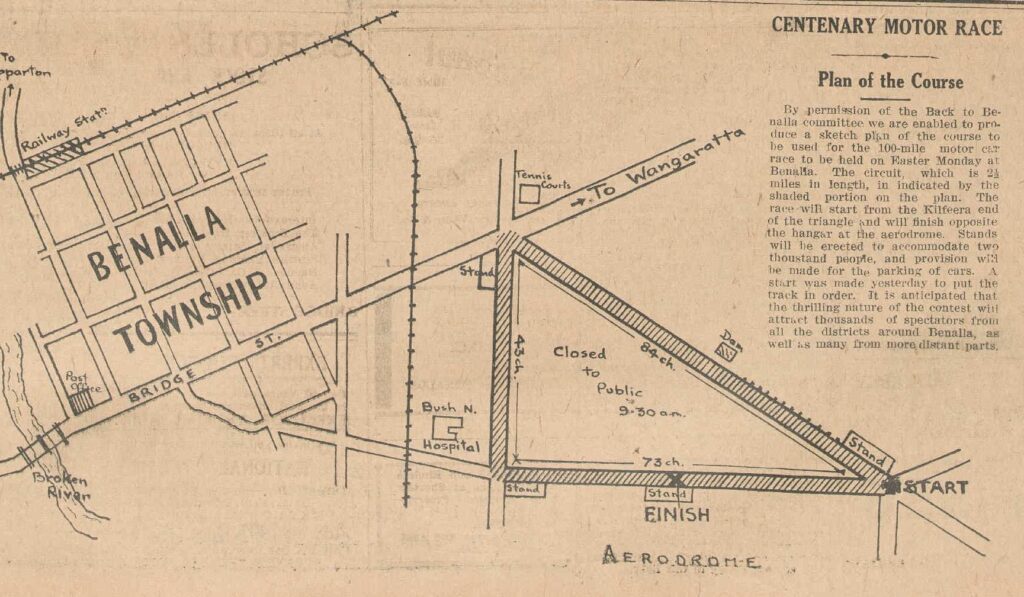
10th April 1936
The 2.5-mile triangular circuit was noted as having a European-styled layout, with “short straights and plenty of tricky corners,” which would place an emphasis on driver skill. Event organisers also released the provision handicaps for the event, with the earliest starter receiving a 20-minute head start.
A lap of the track, per the Benalla Standard:
The race will start from about 200 yards past “Possible Corner,” and will continue on to “Easy Corner” which is excellent, and on which good times will be made. Then comes the short leg from “Easy” to “Bridge Corner,” which will be slow. From “Bridge” to “Easy” – the longest arm of the triangle is very good. Escape roads are available at all corners, and the road surface is being repaired and brought up to the requirements of the police. Scoreboards and pits will be erected; in fact, everything that can be accomplished is being done, and the drivers who enter, as well as the spectators who witness the race, are assured of a very warm reception.
It is noted that at the northern end of the circuit, a short bypass was used to keep the race cars from interfering with what was the Hume Highway.
While contemporary reports have the course running anti-clockwise, period maps and descriptions had the circuit running in a clockwise fashion, a point backed up by a photo of a car in the Argus newspaper, which appears to be making a right-hand turn.
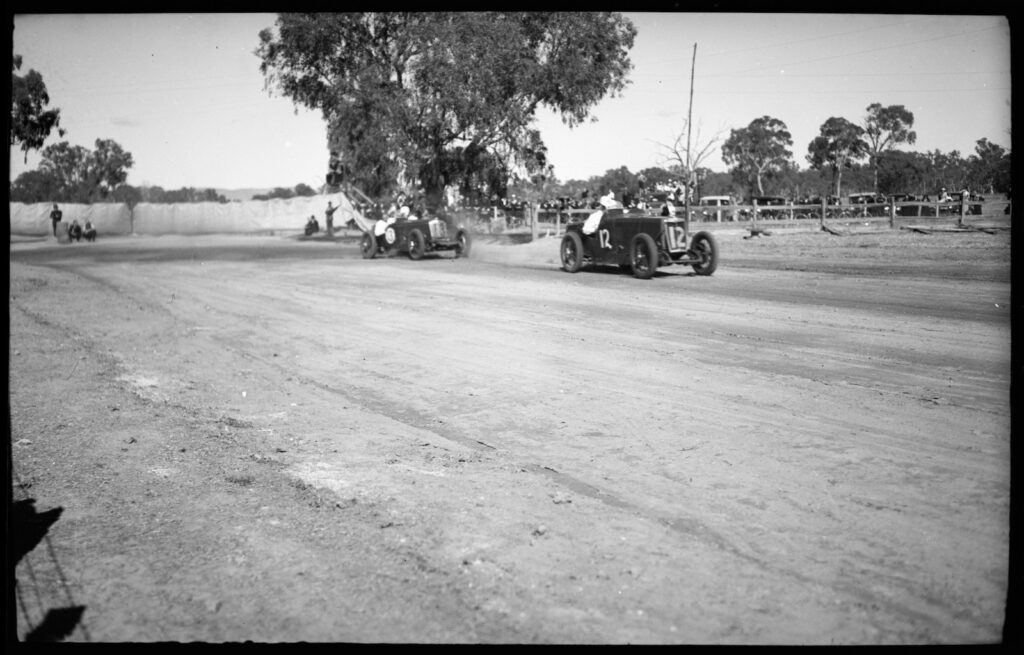
State Library of Victoria
13th April 1936 (race day)
The race was delayed slightly to allow the trainload of 700 race fans from Melbourne to make the 1.5km walk to the circuit.
MOTORING: Car Race Protests – Benalla Lap Charts Wrong!
The Benalla Centenary 100-mile car race today was marred by a mistake in the lap scoring record, and the places cannot be decided until the scores are cross-checked.
All told, five competitors lodged protests against the result, with the short lap distance noted as being difficult to officiate.
The race attracted 21 entries, although only 18 fronted the starter, and while there were a few minor spins, the race went largely without incident.
It was noted that the race attracted 15 to 20,000 spectators – and if these numbers continued into the future, motor racing could count itself as a major sport.
During the race, the dry and dusty surface started to cut up, hampering the backmarkers.
Subsequently, it was reported that for any further races, the corners would be given a seal of bitumen, potentially making the track the best in the southern hemisphere.
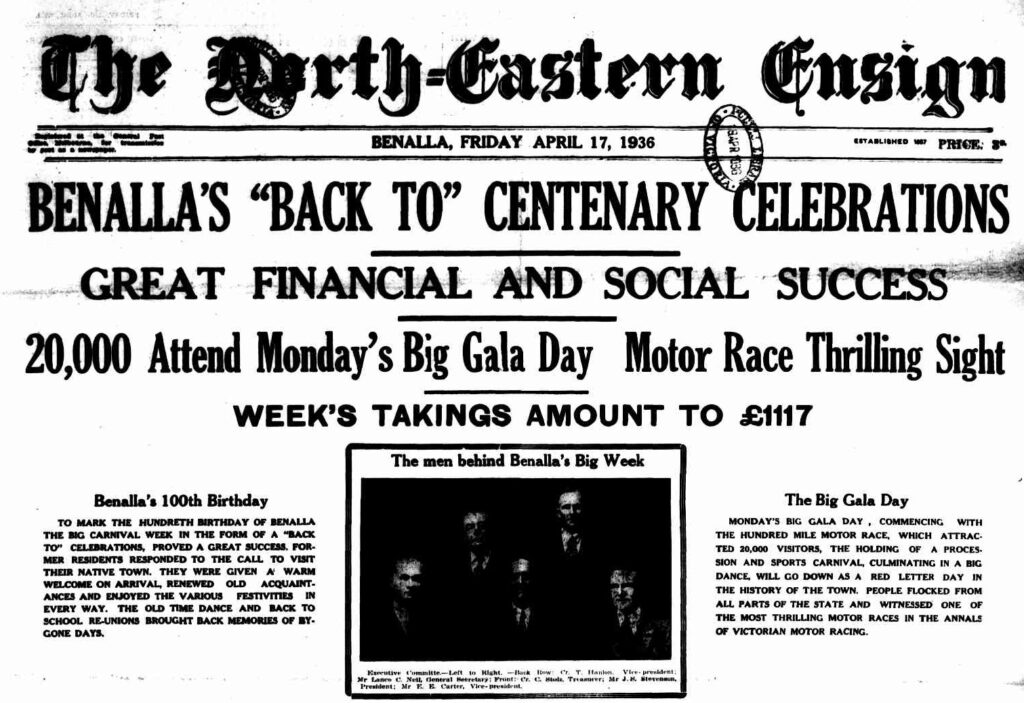
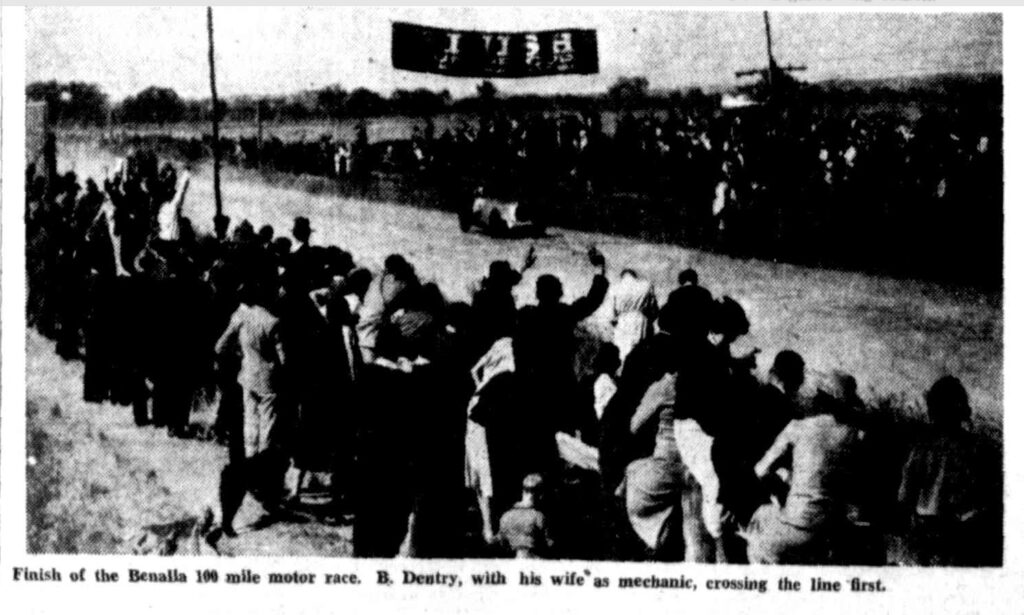
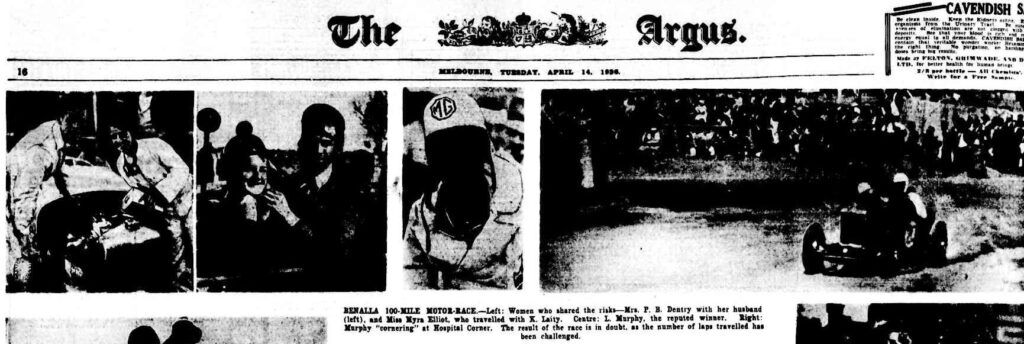
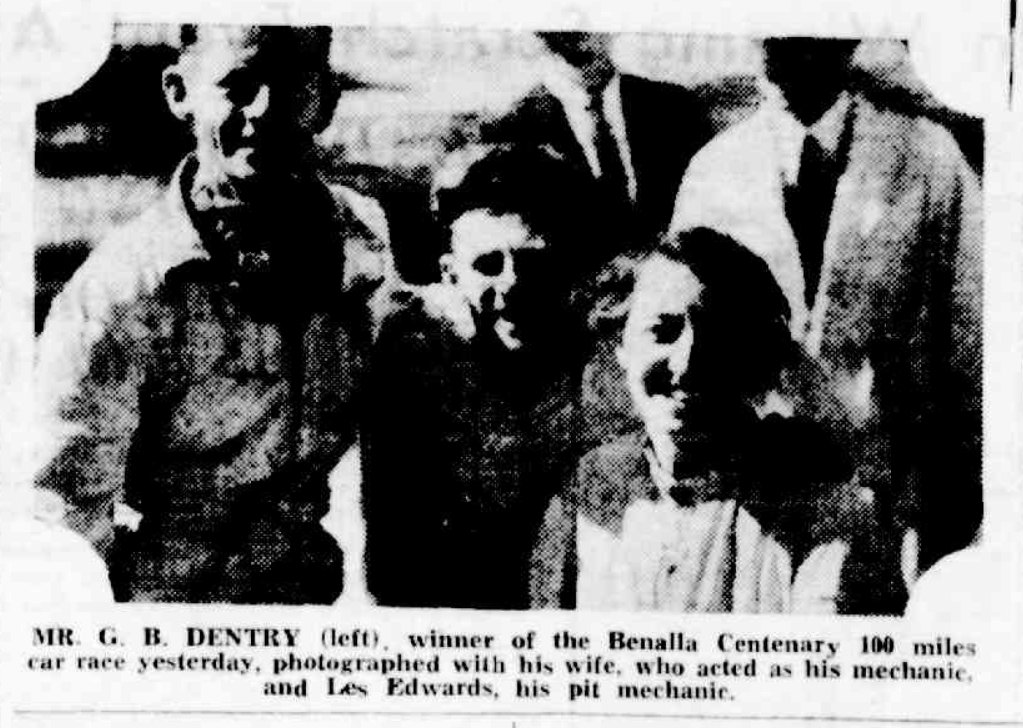
15th April 1936
After Barney Dentry, whose wife Bessie was the riding mechanic in their Riley Special, was initially classified as the winner, Vin Maloney (MG Magna) was awarded the final victory by 46 seconds after it was uncovered that he had actually covered 41 laps rather than the scheduled 40.
Dentry was noted as originally passing Les Murphy (MG P-Type) for the win on the final lap, with the original victory margin being some 100 yards.
It was also reported that the motor race had raised a total of £520, a major contribution to the £1,060 raised on the day.
There will be no encore…
On the King’s Birthday Holiday of 1936, a Midget car race was held at the Benalla Showgrounds on an oval inside the cycling track as organised by the newly formed Benalla and District Motor Car Racing Association.
In front of an estimated audience of 4-6,000 people in sodden conditions, Les Gough claimed the win, while the leading finishers from the 100-mile race were drawn back to Benalla for a scratch race.
Another Midget race followed on December 28.
In January 1937, Norman Hamilton announced at another midget car carnival that he was transferring to near Ballarat, which was a significant blow for motorsport in the local area.
The Benalla Street Race was ultimately a once-only experiment.
Moving into 1938, a push for a Grand Prix race on roads near Wangaratta came to naught when it was scrubbed by the area’s Chief Secretary.
Enthusiasm faded, while the onset of war certainly worked against the motorsport cause.
Racing in the area found various homes post-war, especially rolling into the 1950s, with the Benalla Auto Club being founded in 1957.
In addition to activity on the Wangaratta Airstrip and at Tarrawingee, the BAC’s first circuit racing foray was on the oil-based dirt track at Barjarg in 1958, however, that barebones facility would give way to Winton Raceway, which hosted its first meet in 1961.
What Remains Today
Over time, the aerodrome was enlarged, which saw Boundary Road, the longest straight, disappear from view.
However, looking at modern aerial images, the faint outline of an old drain or access road located to the north of the hangars is almost certainly along the alignment of the original Boundary Road.
What does remain are Kilfeera Road and Samaria Road, although totally sealed and well-developed, including the much more modern Benalla Hospital.
